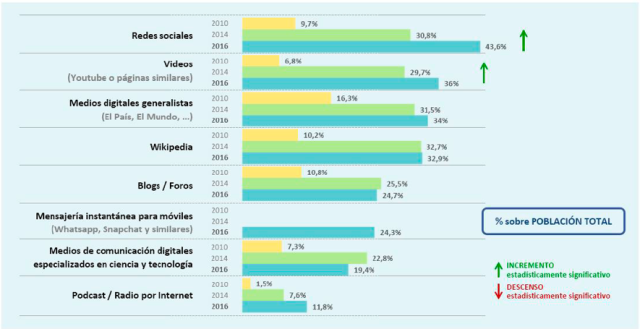Author: Ana Pérez-Escoda Translation: Erika-Lucia Gonzalez-Carrion
In the XXI century the publication of academic and scientific work must be accompanied by a strategy of diffusion intended and scheduled, passing through the promotion of research in social networks. This new need arises associated with the concept of media convergence defined by Henry Jenkins as the flow of content across multiple media platforms, transformed later on in digital convergence: access to knowledge and information in real time from anywhere, across multiple devices connected to Web 2.0.
This context affects to researchers in the way that it gives the possibility to diffuse their research to any place in our planet in only minutes, by offering a diffusion of great reach and impact with a relative effort. Maximizing the rate of their work and showing up his name as investigators will result so easy as using properly the social and academic networks.

The exploitation of this networks as a diffusion strategy of the research offers to the researcher three fundamental elements in their professional development.
- Visibility, in the way that the capacity of reach of the messages shared in networks results exponential.
- Impact, the number of academics and researchers that can access to a scientific work will determine the number of cites that accumulates, the higher impact, the higher number of cites.
- Digital identity, the social projection of the researcher configured for the visibility and impact will constitute a solid digital identity.
In this sense, the social and academic networks allow the researcher to work collaboratively, to share, to diffuse and to connect their work with a number of researchers that could be impossible in another way.
- Research Gate, 6 millions of users and 70 millions of documents.
- Academia Edu, 18 millions of users, 5 millions of publications.
- Mendeley, 3 millions of users and 100 millions of references.
- Facebook, 1.860 millions of users.
- Twitter, 313 millions of active users.
- Linkedin, 500 millions of users all over the world.
- Google Plus, 540 millions of users.
Taking into account this numbers, how to revitalize the research in networks to get a maximum diffusion?
- The first step is to upload the file of work (if the magazine allows it in their privacy policy) to different academic networks: ResearchGate, AcademiaEdu and Mendeley or otherwise a summary or abstract that contains a link to the publication.
- The second step implies to ad a daily post (or each two days during a week) with a different text for each network (Facebook, Twitter, Mendeley and GooglePlus) and linking every day the article since a different network (ResearchGate, AcademisEdu y Meneley), this way it will increase the flow of users that visit the profile in different networks, this will increase the visibility of both the researcher as well as of the research.
- The third clue is to use the appropriate communicative codes to the networks to maximize their possibilities: using hashtags or tags, mentions to people to whom we would like to get directly, links to the profiles or magazines of publication as well as the specific language that gets to the public to which we are directing to.
- The audiovisual effort supposes the fourth necessary action to diffuse in networks. To look for a photo that collects visually the content of the research will be strategic to get the users’ attention.
Without doubt the reach that offer the social and academic networks is indisputable and the impact in the diffusion of science begins to be a fact, as it is confirmed in the VII Encuesta de percepción social de la ciencia done by FECYT, Fundación Española para la Ciencia y la Tecnología in 2016.

The growing that the networks experiment in the diffusion of the science is the key of the visibility of the research in our era and each researcher should support their own strategy to revitalize their work in networks.
